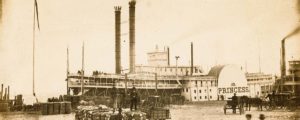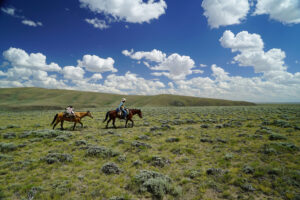The transplant to New Mexico later became a conservationist.
Already friends with Major General Nelson Miles, Englishman turned New Mexican Montague Stevens was pleased in October 1894 when the general introduced him to another hunting guest, artist Frederic Remington. In a 12-page illustrated article in the July 1895 issue of Harper’s New Monthly Magazine, Remington described the bear hunt as a strenuous test of strength and stamina for man and beast. He was impressed by the trailing ability of host Stevens’ dogs and also with the one-armed Stevens’ riding skills. “While our bear-hunting is not the thing we are most proud of,” Remington wrote, “yet the method is most sportsmanlike, since nothing but the most desperate riding will bring one up with the bear in the awful country which they affect.”
By that time Stevens, a highly skilled Western frontiersman often overlooked today, was well established in the Gila River Basin of southwestern New Mexico Territory (present-day Catron County). Unlike many other foreigners, Stevens did more than invest money in the frontier West. For decades, starting in the late 19th century, Stevens demonstrated courage, superior hunting skills and a knack for innovation.
Born in 1859, Montague Stevens first came to America in 1880, two years before graduating from Cambridge University, to hunt big game in Wyoming Territory with guide and outfitter James H. Cook. An experienced cowboy, hunter and Indian scout, Cook taught Stevens about living and hunting in the Rocky Mountains. Stevens only spent a short time in the mountains that year and the following fall, but it was long enough for him to decide his future was in the American West. He returned to England to complete his education and then, fortified by $100,000 from his mother’s estate, he once again ventured to the wilds of Wyoming. After a short visit with Cook, Stevens traveled south to New Mexico Territory. At U.S. Army headquarters in Albuquerque, he met Miles, who allowed him to accompany military scouting operations in western New Mexico Territory and eastern Arizona Territory. On these trips Stevens kept an eye out for good ranching locations.
He decided to start accumulating land and cattle along the San Francisco River, a tributary of the Gila, in southwestern New Mexico Territory. His first partner was Harold C. Wilson of Scotland. The partners’ initial spread, the WS Ranch, lay north of Alma. Realizing he had plenty to learn about the business, Stevens hired Texas cowboy Dan Gatlin as ranch foreman. Gatlin taught his boss the necessary skills to run cattle on the open range, and the two men became great friends. They spent their free moments hunting game and predators.
In December 1888, while the two were hunting geese, Stevens experienced what he later quipped “was probably the most unfortunate happening in any‘wild goose chase.’” The rancher had a shotgun resting across his saddle when his horse spooked and bolted into some thick brush. Stevens quickly grabbed the gun by the barrel, trying to keep the muzzle pointed away from him, but the butt and trigger got tangled in branches, and the shotgun discharged, shattering his left arm. Gatlin helped his boss recover from the accidental shooting; Stevens survived but lost the arm. Five weeks later Stevens started training to regain his keen marksmanship.
Harold Wilson’s son, Brownlow, recalled in a 1980 interview that Stevens would hold his .30–30 lever-action Winchester rifle with his right hand and lay the barrel across the stump of his missing arm in order to aim and fire. To reload he would place the muzzle of the rifle on his left boot, put the butt of the rifle under the stump of his left arm, and work the lever with his right hand. This procedure was perilously slow when out hunting grizzly bears. Stevens was also severely undergunned by today’s standards. His lever-action rifle fired a cartridge that delivered only a fraction of the power provided by magnum cartridges used in modern hunting.
By 1894 Stevens had trained a pack of hunting dogs, using kindness to win their obedience, and had developed a new way of hunting bears—riding horseback alongside the hounds and pursuing the big beasts up to 30 miles into the wilderness. When he felt confident enough, he invited Miles out to the WS Ranch for a bear hunt. Miles brought along Remington. Although the general didn’t bag a grizzly, he did shoot a treed black bear and considered the hunt a success. Remington gave the occasion much publicity with his Harper’s article. Celebrities or no, Stevens was ever ready to hunt. Neighboring ranchers needed only to get word to him that a grizzly had killed a cow or sheep, and he would arrive at the site before the trail went cold. Hunting grizzlies, which could weigh up to 800 pounds, was Montague’s greatest passion, and he had several close calls with the big beasts.
The Jewett Gap grizzly, as one unusually large old bear was known, had killed many cattle and sheep, and not just for food. Despite large bounties put on his hide, the griz had eluded hunters and trappers for 10 years. One spring day in 1896, Stevens got word that the outlaw bear had killed 40 sheep. The hunter and his hounds hurried to the scene, picked up the bear’s trail and followed it for miles, until they came upon a dead sheep carcass with a broken neck. The renegade grizzly had eaten his fill and fled, but his trail was hot, and Stevens’ hounds resumed the hunt.
An hour later the hounds jumped the Jewett Gap grizzly out of his bed, and the chase was on. The bear headed up a nearby mountain, sticking to the roughest terrain and seeking sanctuary in the thick brush near the timberline. Stevens stayed in the saddle but repeatedly had to detour around terrain his horse was unable to negotiate. Two of the hounds, trained as “slow trailing dogs,” kept close to Stevens while following the main pack. Even when the pack ran out of hearing distance, this pair kept the hunter on the bear’s trail.
It was nearly dark when Stevens finally spotted his prey. The exhausted grizzly was sitting on his haunches, watching the dogs bay at him at a safe distance, about 30 yards down a steep cliff. Stevens dismounted and moved within range for a shot. But as he took aim, two of his dogs circled around to attack the bear from behind. The bear stood up and slapped at the dogs. At that moment, Stevens fired at the bear’s throat, hoping the slug would break its neck. But instead of dropping to the ground, the bear turned and charged.
Stevens rushed to reload while standing on one foot. He got a round in the chamber and raised the rifle, but there was no time to aim. All he could do was thrust the rifle forward and, as the muzzle touched a spot between the bear’s shoulders, pull the trigger. The bullet broke the bear’s spine even as the animal’s momentum propelled it forward and downhill.
Later, while skinning the bear, Stevens learned why his first shot had not stopped the beast. The slug had struck the bear’s right front paw as it was swatting at the hounds. “Incidents such as that,” the hunter later said, “have a tendency to undermine one’s self-confidence, and self-confidence is an indispensable requisite in hunting grizzlies.”
In May 1897 Stevens was in New York City, visiting Remington, when the artist introduced his friend Theodore Roosevelt, then police commissioner. Teddy said he would make the trip to New Mexico Territory if he were guaranteed to bag a grizzly. Stevens said he first needed to work more with his hounds. By summer 1902 Stevens had his hounds ready, but tragedy struck before he could contact Roosevelt, now president.
A neighbor, trying to kill coyotes with a strychnine-laced steer carcass, had accidentally poisoned Stevens’ beloved dogs. Grief-stricken, Stevens hung up his rifle and vowed never to hunt again. His interests turned toward conservation, and he lectured about the need to protect wildlife, particularly the grizzly bears. At the end of his 1943 book Meet Mr. Grizzly, he wrote, “I became a zealous convert to their preservation, to prevent so noble an animal becoming extinct.” He kept up the crusade until late in life. He died in 1953 at age 94 in his Albuquerque home. Montague Stevens was more than just a lover of hunting. He was an entrepreneur, a practitioner of humane animal training methods, an innovator and, in the 20th century, a hardworking conservationist.
Originally published in the October 2011 issue of Wild West. To subscribe, click here.




